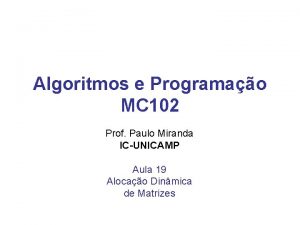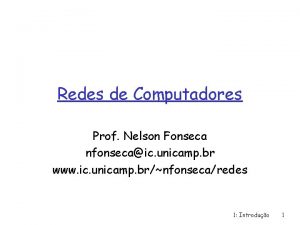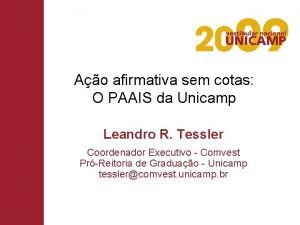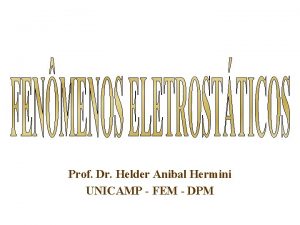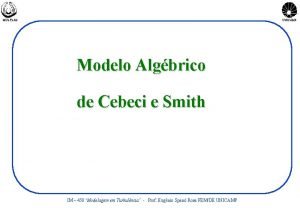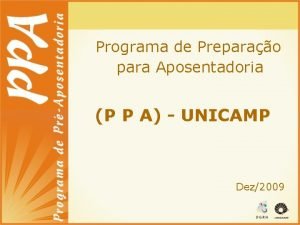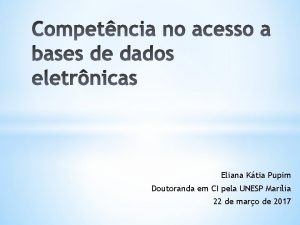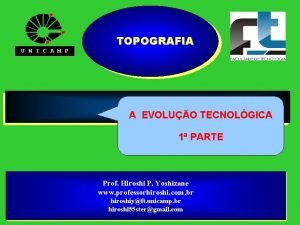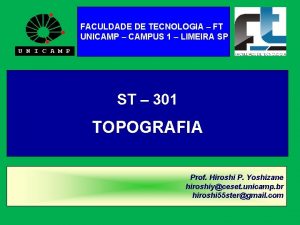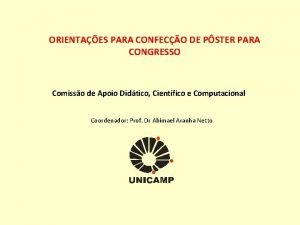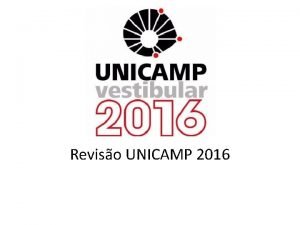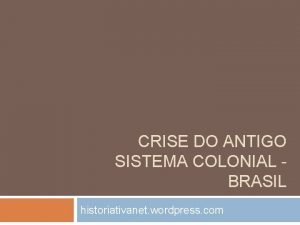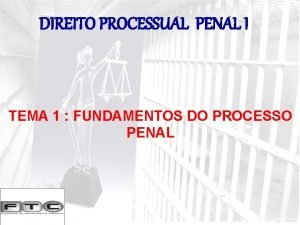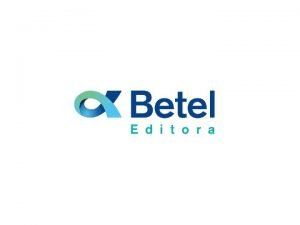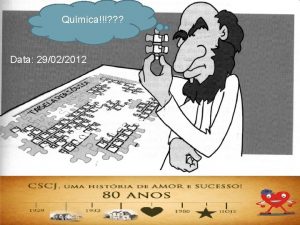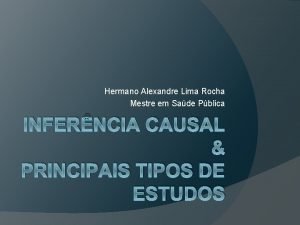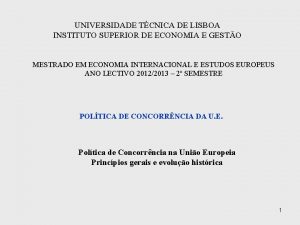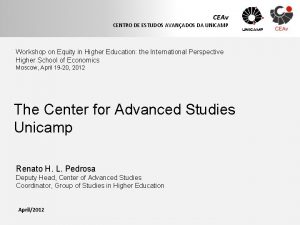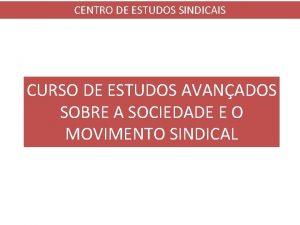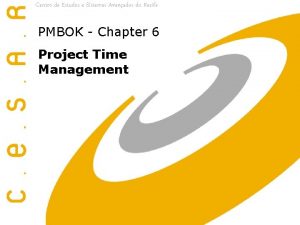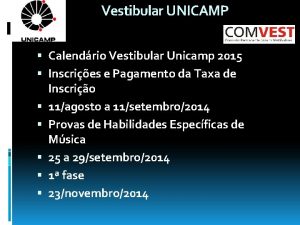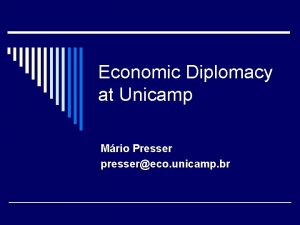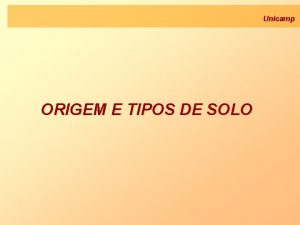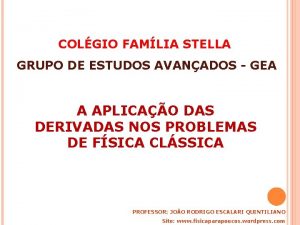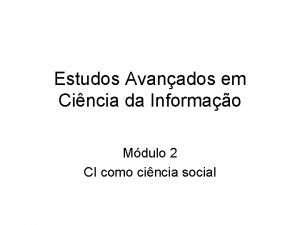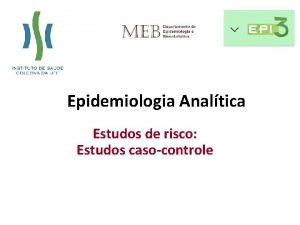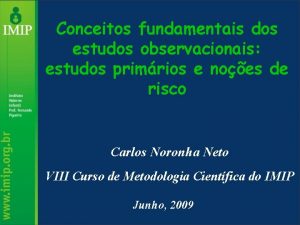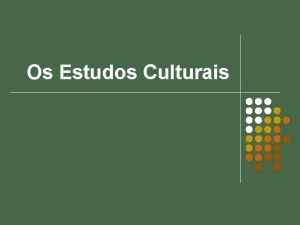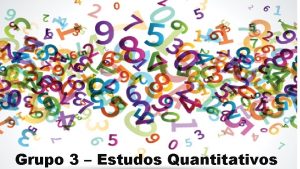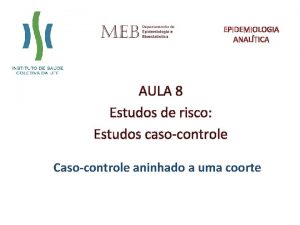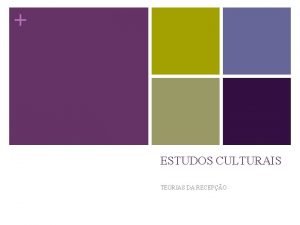CEAv CENTRO DE ESTUDOS AVANADOS DA UNICAMP Workshop



















- Slides: 19

CEAv CENTRO DE ESTUDOS AVANÇADOS DA UNICAMP Workshop on Equity in Higher Education: the International Perspective Higher School of Economics Moscow, April 19 -20, 2012 Access to higher education in Brazil: the challenges of quality and equity Renato H. L. Pedrosa Deputy Head, Center of Advanced Studies Coordinator, Group of Studies in Higher Education

CEAv CENTRO DE ESTUDOS AVANÇADOS DA UNICAMP Outline § § Overview of Brazilian higher education system A bit of history: 1960 -2010 § § Access: national vs local systems Access: standardized tests vs ? § § § The challenge of equity: race/ethnicity and SES The challenge of quality vs quantity: engineering programs The challenge of equity vs quality: Prouni (federal program) The challenge of equity+quantity: the Technological Colleges, São Paulo The challenge of quality+equity: Unicamp’s programs § What’s next in Brazil: more challenges Pedrosa Equity in Higher Education: the International Perspective - Higher School of Economics, Moscow, April 19 -20, 2012

CEAv CENTRO DE ESTUDOS AVANÇADOS DA UNICAMP Higher education in Brazil, 2010 • Area: 8. 5 million sq km • GDP = U$ 2. 6 trillion (U$13, 500 GDP/capita) • Higher Education • • • 2, 378 institutions (278 public) 190 universities (101 public) 6. 3 million undergrad students enrolled 5. 4 million in presential programs 76% of enrollments in the private system 50% in for-profit institutions Net enrollment ratio (18 -24 age cohort): 15% • • Population: 192 million Gross enrollment ratio: 27% Federal system • • 58 universities, 37 Technological Institutes and 4 Colleges 930, 000 undergraduate students 820, 000 in presential programas 15% of total undergraduate enrollment Pedrosa Equity in Higher Education: the International Perspective - Higher School of Economics, Moscow, April 19 -20, 2012

CEAv CENTRO DE ESTUDOS AVANÇADOS DA UNICAMP Higher education in the state of São Paulo • 22% of the Brazilian population: 41 million • 33% of Bazilian GDP = U$ 850 billion (U$21, 000 GDP/capita) • Higher Education • • • State Public HE system • • 26% of all enrollment = 1. 63 million (1. 47 million in presential programs) 32% of graduating class: 260, 000 of 830, 000 total Net enrollment ratio: 18% (34% gross enrollment ratio) 86% in private HEIs (3/4 of those in for-profit HEIs) Small federal participation, only 1. 5% of enrollment Best university system in Brazil 3 universities, 28 campi, 120, 000 undergraduate students, 50, 000 graduate students 52 State Technical Colleges (FATECs), 55, 000 students But still, only 14% of all enrollment is in public HEIs Pedrosa Equity in Higher Education: the International Perspective - Higher School of Economics, Moscow, April 19 -20, 2012

CEAv CENTRO DE ESTUDOS AVANÇADOS DA UNICAMP HE in Brazil 1960 -1994 • 1960: about 140, 000 students enrolled in HE • 1980: number had grown to about 1. 4 million (+900%) • 1980 -1994: • Longest period of economic stagnation in Brazil’s republican history • Little development in HE, public or private • Enrollment in 1994 = 1. 7 million (+21%) Pedrosa Equity in Higher Education: the International Perspective - Higher School of Economics, Moscow, April 19 -20, 2012

CEAv CENTRO DE ESTUDOS AVANÇADOS DA UNICAMP HE in Brazil 1995 -2010 • Economic growth • Expansion of private sector • New National Law of Education (1996) • New paths for diversification of system • Deregulation • Universalization of basic education (1 st-8 th grades) and increase of number of secondary education graduates (though that has stagnated recently) • HE enrollment in 2010: 6. 3 million (+270% over 1994 figure) • BUT: most growth was in the private sector, mostly in the for-profit sybsector Pedrosa Equity in Higher Education: the International Perspective - Higher School of Economics, Moscow, April 19 -20, 2012

CEAv CENTRO DE ESTUDOS AVANÇADOS DA UNICAMP Undergraduate enrollment in presential programs, 1980 -2010 Census of Higher Education, Ministry of Education, Brazil Pedrosa Equity in Higher Education: the International Perspective - Higher School of Economics, Moscow, April 19 -20, 2012

CEAv CENTRO DE ESTUDOS AVANÇADOS DA UNICAMP Access: national vs local systems • Up to 2009, Brazilian HEIs developed their own admission systems • • Vestibular (non-standardized oral/written/MC examinations) Nat’l Ed Law-NEL of 1968 required HEIs to use vestibular • With new Nat’l Ed. Law-NEL (1996), HEIs had freedom to choose methodology, but all selective universities kept to the vestibular tradition • 1998: Ministry of Education-ME starts High School National Exam (ENEM) (nonstandardized, written essay + 68 MC items, 4 hr test) • 1998 -2008: many HEIs start to use ENEM as part of their admission systems • 2009: ME changes ENEM and establishes a national admissions system (SISU) • • Standardized via IRT WE + 180 MC items, 2 -day test (total = 9 hrs) SISU allows for applicants to choose among all participant HEIs Many federal HEIs adopted the system, but not the most selective Pedrosa Equity in Higher Education: the International Perspective - Higher School of Economics, Moscow, April 19 -20, 2012

CEAv CENTRO DE ESTUDOS AVANÇADOS DA UNICAMP Access: standardized vs ? • Vestibular still enjoys a strong appeal • • • Credibility: no security issues at more selective HEIs Perceived as “just” (“same for all”) Meritocratic: score is indication of present performance Admission is a “prize” for that performance Score usually assumed as good predictor of future performance • ENEM, although standardized, lack same credibiliy, due to security issues that have plagued editions since 2009 • Research indicates standardized tests have limitations, may show bias against certain groups (minorities, women) and that HS grades and other applicants’ characteristics may play a relevant role in predicting future academic performance • • SAT and later performance (J. Soares, W. Bowen et al) SAT and gender (U Cal studies) Brazil: Unicamp study about vestibular, later performance, SES and gender (Pedrosa et al) Very few alternative systems; affirmative action comes as some sort of remedy for perceived “elitism” of pure Vestibular/Enem systems Pedrosa Equity in Higher Education: the International Perspective - Higher School of Economics, Moscow, April 19 -20, 2012

CEAv CENTRO DE ESTUDOS AVANÇADOS DA UNICAMP The challenge of equity: race/ethnicity and SES • Over 50% of the young (18 -24) in Brazil declare themselves as blacks (B) or pardos (P) (of mixed race/color) • • 30% in the state of São Paulo, but about 50% in Rio de Janeiro and over 70% in some NE states like Bahia Overall in Brazil, about xx% of enrolled students belong in that group, less so in public universities • In the public universities in São Paulo, less than 15% of the students say they belong in that group. • In the public universities in SP, about 25% of enrolled students have families with a total yearly income of U$20, 000 or less, even though group comprises about 50% of the SP population • But: situation was much worse 10 or 15 years ago. For example, in the SP public universities, as late as 2004, only 10% or less of the student pop. belonged in the B/P group • What happened: expansion + affirmative action policies Pedrosa Equity in Higher Education: the International Perspective - Higher School of Economics, Moscow, April 19 -20, 2012

CEAv CENTRO DE ESTUDOS AVANÇADOS DA UNICAMP The challenge of equity vs quality: Prouni (federal program) • Started 2005 • Public is low-income students graduating from public HS system • Fiscal waiver for private HEIs • About 120, 000 admissions per semester currently, one million scholarships granted since 2005 • Uses ENEM as only admission criterion • Detailed data related to program is not made public • There’s provision for quality requirements for programs/institutions to participate, but data and information regarding compliance has not been released as well Pedrosa Equity in Higher Education: the International Perspective - Higher School of Economics, Moscow, April 19 -20, 2012

CEAv CENTRO DE ESTUDOS AVANÇADOS DA UNICAMP The challenge of quality vs quantity: engineering programs • In 2008, 32, 000 new engineers graduated from Brazilian HEIs • Some 26, 000 participated in the Enade test that’s part of the National System of Higher Ed Assessment (Sinaes) • Enade is composed of general education and subject area items, both written and MC • Program is scored 1 -5 using its students’ scores, 5 being the top one • The Ministry of Education considers that levels 4 and 5 should be considered adequate • But among lower scores in level 4 one finds averages that are half of top scores • Even so, only 28% of all graduating engineering students were enrolled in programs scoring 4 or 5, which indicates that most graduates lacked very basic knowledge expected from engineers • Splitting public vs private: 48% of those enrolled in public HEIs and 11% of those in private HEIs belonged in 4/5 level programs Pedrosa Equity in Higher Education: the International Perspective - Higher School of Economics, Moscow, April 19 -20, 2012

CEAv CENTRO DE ESTUDOS AVANÇADOS DA UNICAMP The challenge of equity+quantity: the State Technological Colleges, São Paulo • Started in 1969, but only in the last 10 years has seen expressive growth • Offers 3 -year programs with direct links to job market (but also in some traditional areas, like technical health training) • Spreaded across the state, each campus offers programs related to the local economy • State investment has grown 5 -fold in the Fatec system from 2005 to 2010 – No cuts in the state universities’ budgets • Employability 1 year after graduation: 92% – Some programs reach 96% or more: construction, information systems • Average monthly salary 1 year after graduation – – $1, 500 About 75% of average salary in traditional academic careers in Brazil More than wages in some traditional academic degrees Follows OECD countries’ average Pedrosa Equity in Higher Education: the International Perspective - Higher School of Economics, Moscow, April 19 -20, 2012

CEAv CENTRO DE ESTUDOS AVANÇADOS DA UNICAMP Pedrosa Equity in Higher Education: the International Perspective - Higher School of Economics, Moscow, April 19 -20, 2012

CEAv CENTRO DE ESTUDOS AVANÇADOS DA UNICAMP The challenge of quality+equity: Unicamp’s programs 1. General affirmative action program - PAAIS • Based on a study that followed all students admitted during the years 1994 -1997 until they graduated or dropped out • Pedrosa et all, 2007, Higher Ed Management and Policy (OECD) • The study showed that students that had graduated from public HS or had low income or were women, performed better during their academic life than the complementary groups • University used that info to develop a program that attributed extra points in the vestibular, increasing their chance to being admitted Pedrosa Equity in Higher Education: the International Perspective - Higher School of Economics, Moscow, April 19 -20, 2012

CEAv CENTRO DE ESTUDOS AVANÇADOS DA UNICAMP Med. Ical School/UNICAMP 2003 -2004: 11 students coming from public schools - 10% 2005: 33 students coming from public schools – 30% 2003 -2004: 5 blacks/pardos 2005: 11 blacks/pardos Ranking with extra points Ranking without extra points Ranking at end of 4 th year Pedrosa Equity in Higher Education: the International Perspective - Higher School of Economics, Moscow, April 19 -20, 2012

CEAv CENTRO DE ESTUDOS AVANÇADOS DA UNICAMP The challenge of quality+equity: Unicamp’s programs 2. Best students program - PROFIS • Facts • • • Action • • • Campinas has 96 public high schools In 2008 -2009, more than half didn’t have a single student enrolled in Unicamp’s programs Unicamp developed a “Texas” style program, admitting at least one student from every HS in the city, as many as two, in a new program, with a general education flavor Students would choose their major after two years in that program, including the most selective (medicine, engineering, etc. ) Results (Andrade et al, preprint Unicamp, 2012) • • • Still in the beginning of second year, not much info on academic performance Drop-out rate is lower than Unicamp’s average Much lower SES compared to general Unicamp student pop. (actually, lower than general SP pop. ) Parents with much lower educational level than general Unicamp student pop. More black/pardos than in the SP population (even more than in the Campinas pop. ) Pedrosa Equity in Higher Education: the International Perspective - Higher School of Economics, Moscow, April 19 -20, 2012

CEAv CENTRO DE ESTUDOS AVANÇADOS DA UNICAMP What’s next in Brazil: more challenges • It’s clear not enough is being done across the board in terms of access and equity in Brazil, especially if quality is brought into the picture • Brazil’s HE system is plagued by governance issues, including the public sector • Brazil’s public HE system is not as efficient as could be, student/faculty ratio is in the low 10 s • Federal system is quite unequal in most aspects, from financing to academic qualifications • Still, it is much better qualified than the private sector • The not-for-profit sector is disappearing, now more than 2/3 of the private sector is forprofit • Most recent growth is happening in the less qualified part of the private sector, including strategic areas like engineering • Very recently, most growth is in distance learning, with dubious quality and usually low efficiency Pedrosa Equity in Higher Education: the International Perspective - Higher School of Economics, Moscow, April 19 -20, 2012

CEAv CENTRO DE ESTUDOS AVANÇADOS DA UNICAMP Thank you! Renato H. L. Pedrosa renato. pedrosa@reitoria. unicamp. br http: //www. gr. unicamp. br/ceav/english/index. php http: //www. revistaensinosuperior. gr. unicamp. br/ Equity in Higher Education: the International Perspective - Higher School of Economics, Moscow, April 19 -20, 2012
 Cz hipodromo
Cz hipodromo Ufrgs diamante e grafite sao variedades
Ufrgs diamante e grafite sao variedades Mc102 unicamp
Mc102 unicamp Nelson fonseca unicamp
Nelson fonseca unicamp Paais 0 unicamp
Paais 0 unicamp Femdpm
Femdpm Multlab
Multlab Dgrh unicamp vida funcional
Dgrh unicamp vida funcional Acervus unicamp
Acervus unicamp Cad unicamp
Cad unicamp Unicamp o impressionante exercito de argila
Unicamp o impressionante exercito de argila Unicamp limeira ft
Unicamp limeira ft Fcm unicamp
Fcm unicamp Unicamp reproduzimos abaixo a chamada
Unicamp reproduzimos abaixo a chamada Modle ufv
Modle ufv Princípios direito processual penal
Princípios direito processual penal Ortopatia
Ortopatia Observe as especies a seguir 16o8 23na11
Observe as especies a seguir 16o8 23na11 Tipos de estudo epidemiologico
Tipos de estudo epidemiologico Estudos europeus
Estudos europeus


